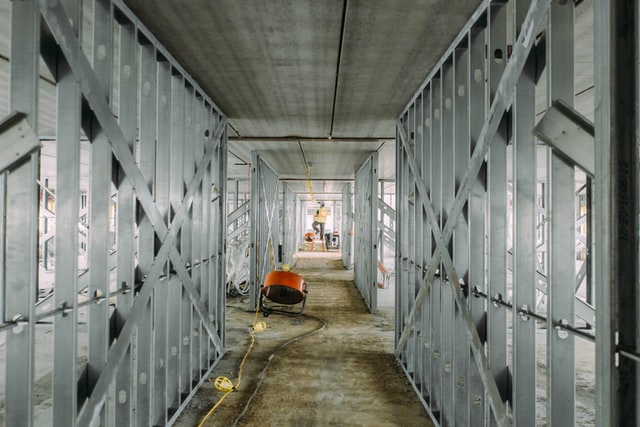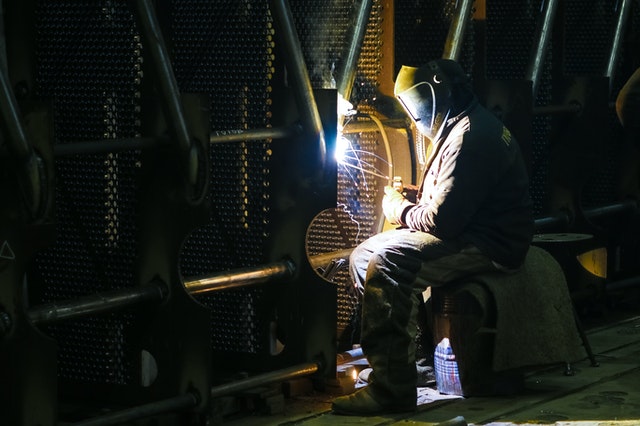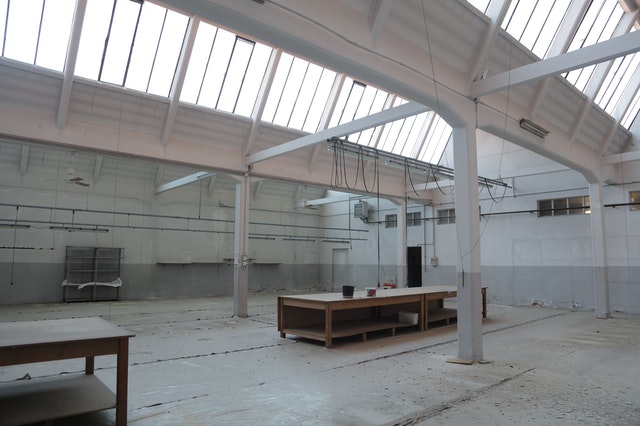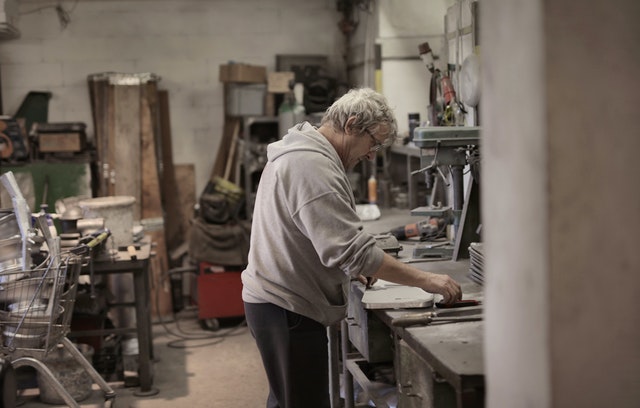This is an excerpt from the Book called “Drywall “ by W. Robert Harris. Continue reading to learn more about Metal Stud Walls, thanks to the author.
Metal Framing Assemblies
Light-gauge metal studs are used to frame partitions and heavy-gauge metal studs are used to frame load-bearing and nonload-bearing exterior walls. Suspended drywall ceilings are constructed with drywall furring channels. Shaftwalls use drywall to provide required fire ratings.
Metal Stud Walls
The walls and partitions of commercial buildings are commonly constructed with metal studs. Light-gauge metal studs are used for partition framing. Heavy-gauge metal studs are used for load-bearing and nonload-bearing exterior walls.
Metal studs are economical, non-combustible, and lightweight. Light-gauge metal partitions can be quickly installed and removed. Heavy-gauge metal stud walls provide a system that is structurally sound.
Light-Gauge Metal Stud Walls
Noncombustible light-gauge metal studs are used for wall or partition framing in malls, strip centers, and high-rise structures. Prior to beginning construction of light-gauge metal stud partitions, the framer should examine the material supplied to determine whether or not it complies with the construction plans and specifications. The width, length, gauge thickness, manufacturer, and quantity of metal framing material should be checked to confirm that a sufficient number of properly-sized studs and tracks have been supplied to complete the work.
Layout And Track Installation.
Six layout and track installation steps are recommended and should be followed when constructing light-gauge metal stud partitions:

- Determine the location of the partitions from the floor plan or from the reference marks provided.
- Mark the locations on the floor or confirm that the layout provided is accurate. Use a chalk line to mark the locations of the partition tracks on the floor.
- Transfer the layout to the ceiling grid or overhead structure using a plumb bob or laser level.
- Lay out the locations of all doors, windows, and other openings. Clearly mark these locations on the floor.
- Fasten the tracks to the ceiling or overhead structure.
- Fasten the tracks to the floor.
Tracks are usually fastened to the ceiling or overhead structure before they are fastened to the floor to allow easy access for the rolling scaffold and to prevent damage to the bottom tracks. Fasteners used to attach the tracks must be the specified type, length, and diameter and must be placed at the intervals indicated on the plans, listed in the specifications, or as determined by the AHJ.
Stud Installation.
Seven installation steps are recommended and should be followed when constructing light-gauge metal stud partitions:
- Lay out the stud spacing on the top and bottom tracks. Studs are placed at the intervals indicated on the plans, listed in the specifications, or as determined by the AHJ.
- Measure the floor-to-ceiling distance between the top and bottom track to determine the stud length.
- Cut studs approximately ½” shorter than the floor-to-ceiling dimension.
- Stand the studs within the top and bottom tracks and twist them into place. The stud spacing must be accurately maintained to avoid unnecessary cutting of the drywall sheets.
- Frame door, window, and other openings with tracks at the top of door openings and at the top and bottom of window and other openings. Heavy-gauge studs may be required for the sides of door and window openings. This must be determined from the plans or specifications before proceeding. Door and window studs may also require ¾” or 1 ½” cold-rolled steel channel braces.
- Anchor each stud to the top and bottom tracks with self-drilling, self-tapping framing screws.
- Install partition bracing or backing as required.
Framing Inspections.
Upon the completion of the partition framing, check all partitions to make sure that they are straight and plumb and that the stud spacing is accurate. When framing inspections are required, they will be requested after the other tradesworkers (plumbers, electricians, etc.) have completed their work. This ensures that any cuts made in the framing members by these workers have been repaired and that the framing is intact. The drywall sheets are applied to the partition framing after the other tradesworkers have completed their work and the work has been inspected.


Heavy-Gauge Metal Stud Walls
Noncombustible heavy-gauge metal studs are used extensively for both load-bearing and nonload-bearing exterior wall framing. Prior to beginning the construction of any heavy-gauge metal stud walls, the framers should examine the material supplied to determine whether or not it complies with the construction plans and specifications. Heavy-gauge framing components shall comply with the requirements because the structural integrity of the building is dependent on properly framed and braced exterior walls. The name of the manufacturer, width, length, and gauge thickness of all studs and tracks must be checked. The quantity of metal framing material should also be checked to confirm that sufficient studs and tracks have been supplied to complete the work.
Layout And Track Installation.
Six layout and track installation steps are recommended and should be followed when constructing heavy-gauge metal stud partitions:
- Determine the location of the walls from the floor plan or from the reference marks provided.
- Mark the locations on the floor or confirm that the layout provided is accurate. Use a chalk line to mark the locations of all wall tracks on the floor.
- Transfer the layout to the overhead structure using a plumb bob or laser level.
- Lay out the locations of all doors, windows, and other openings. Clearly mark these locations on the floor.
- Fasten the tracks to the overhead structure.
- Fasten the tracks to the floor.
The overhead tracks are usually fastened to the structure before the bottom tracks are fastened to the floor for two reasons:
- The spray-applied fireproofing should be installed after the top tracks are in place to ensure an adequate seal between the walls and the decking or beams.
- Installing the top tracks first allows access for rolling scaffolds and reduces the damage to the bottom tracks.
Fasteners used to attach the tracks must be the specified type, length, and diameter and must be placed at the intervals indicated on the plans, listed in the specifications, or as determined by the AHJ. If welds are specified for attaching the top tracks to the overhead structure, they must be the proper length, width, spacing, and locations indicated on the plans or listed in the specifications.
Stud Installation

Six installation steps are recommended and should be followed when constructing heavy-gauge metal stud walls:
- Lay out the stud spacing on the top and bottom tracks.
- Measure the distance between the top and bottom track to determine the stud length. If the wall is load-bearing, the studs must be full-length and must be properly seated in the top and bottom tracks. When a nonload-bearing wall is being constructed, studs may be cut approximately ½” shorter than the floor-to-ceiling dimension.
- Place the studs within the top and bottom tracks and twist into place. Stud spacing must be accurately maintained to ensure that the design criteria are met and to avoid unnecessary cutting of the drywall.
- Frame door, window, and other openings with tracks or box headers at the top of the openings and track at the sills of windows and other openings.
- Securely anchor studs to the top and bottom tracks with self-drilling, self-tapping framing screws or welds.
- Be sure all wall bracing and backing is installed as required.
Heavier gauge studs may be required for the sides and headers of door and for window openings. Check the plans and/or specifications to determine stud sizes. Door and window studs may also require ¾” or 1 ½” cold-rolled steel channel braces.
Framing Inspections.
After completing the wall framing, check to be sure that all walls are straight and plumb and the stud spacing is accurate. Framing inspections are required for heavy-gauge walls. They are called for after the other tradesworkers have completed their work. This ensures that all cuts made to the framing members have been repaired and the framing is structurally intact. The drywall and gypsum sheathing is installed on the wall framing after the other tradesworkers have completed their work and the walls have passed inspection.

